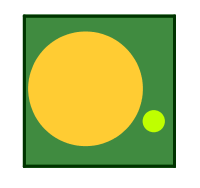Is it the smallest?
 Given two non-overlapping circles of radii
1
7
and
9
9
, what is the smallest square which can contain them?
Given two non-overlapping circles of radii
1
7
and
9
9
, what is the smallest square which can contain them?
If the side length of such a square is s , submit ⌊ 1 0 0 s ⌋ .
The answer is 19802.
This section requires Javascript.
You are seeing this because something didn't load right. We suggest you, (a) try
refreshing the page, (b) enabling javascript if it is disabled on your browser and,
finally, (c)
loading the
non-javascript version of this page
. We're sorry about the hassle.
2 solutions
@Chew-Seong Cheong , Thanks for your response. One small addition: the side length of the smallest square is 9 9 + ( 9 9 + 1 7 ) cos 4 5 ∘ + 1 7 , because this exceeds 1 9 8 . Otherwise, the minimum side length would be exactly 1 9 8 and the smaller circle wouldn’t be tangent to two sides of the square and the big circle simultaneously. Thanks again for giving time in solving my problems.
For the tightest fit, consider a square as in the picture, with the smaller circle tangent to two adjacent sides of the square, the larger circle tangent to the two opposite sides, and the two circles tangent to each other. The distance between the two centers is 1 7 + 9 9 = 1 1 6 .
To find the width of this square, we add the lengths of the two radii to the side length of the right isosceles triangle whose hypotenuse connects the two circles' centers. With a hypotenuse length of 1 1 6 , the two legs each have length 2 1 1 6 = 8 2 . 0 2 4 . Thus the side length of the square is 1 1 6 + 8 2 . 0 2 4 = 1 9 8 . 0 2 4 .
Note that 1 9 8 is the minimal side length possible for a square containing a circle of radius 9 9 . What I've calculated is the horizontal distance from the left side of the larger circle to the right side of the smaller circle. Had this quantity been less than 1 9 8 , the answer would have been 1 9 8 .
@Richard Desper , @Chew-Seong Cheong . How do you know that this is the tightest fit?
@Thanos Petropoulos , @Richard Desper , see my proof.
As shown in the figure, the side length of the smallest square is s = 9 9 + ( 9 9 + 1 7 ) cos 4 5 ∘ + 1 7 ≈ 1 9 8 . 0 2 4 ⟹ ⌊ 1 0 0 s ⌋ = 1 9 8 0 2 .
Proof: This is in response to @Thanos Petropoulos 's question. Referring to the figure above. The left side and the bottom side of the square are as tight fit as possible. Any variation in the square size comes from the right and top sides. Basically it depends on relative position of the small circle with the large circle. We have placed the small circle touching the big circle so as to be as tight as possible. Now the relative positions of the two circles only depend on the angle between the line joining the two circle centers and the x -axis or any other reference line. Let take the x -axis for convenient and call the angle θ . In the figure θ = 4 5 ∘ . It can be seen that if θ < 4 5 ∘ , the further right point of the small circle moves to the right or x -direction hence increasing the size of the square. If θ > 4 5 ∘ , it increases the y -dimension and hence the size of the square. In fact the size of the square is symmetrical about y = x or the 4 5 ∘ -line. Anyway, I provide a mathematical proof here.
Consider 0 ∘ ≤ θ ≤ 4 5 ∘ , all other ranges of θ are reflection of this range. Then the side length of the square is given by a ( θ ) = 9 9 + 1 1 6 cos θ + 1 7 = 1 1 6 ( 1 + cos θ . a ( θ is smallest when cos θ is smallest. For 0 ∘ ≤ θ ≤ 4 5 ∘ , cos θ is smallest when θ = 4 5 ∘ . For 4 5 ∘ ≤ θ ≤ 9 0 ∘ , a ( θ ) = 1 1 6 ( 1 + sin θ . Again a ( θ ) is smallest when θ = 4 5 ∘ .